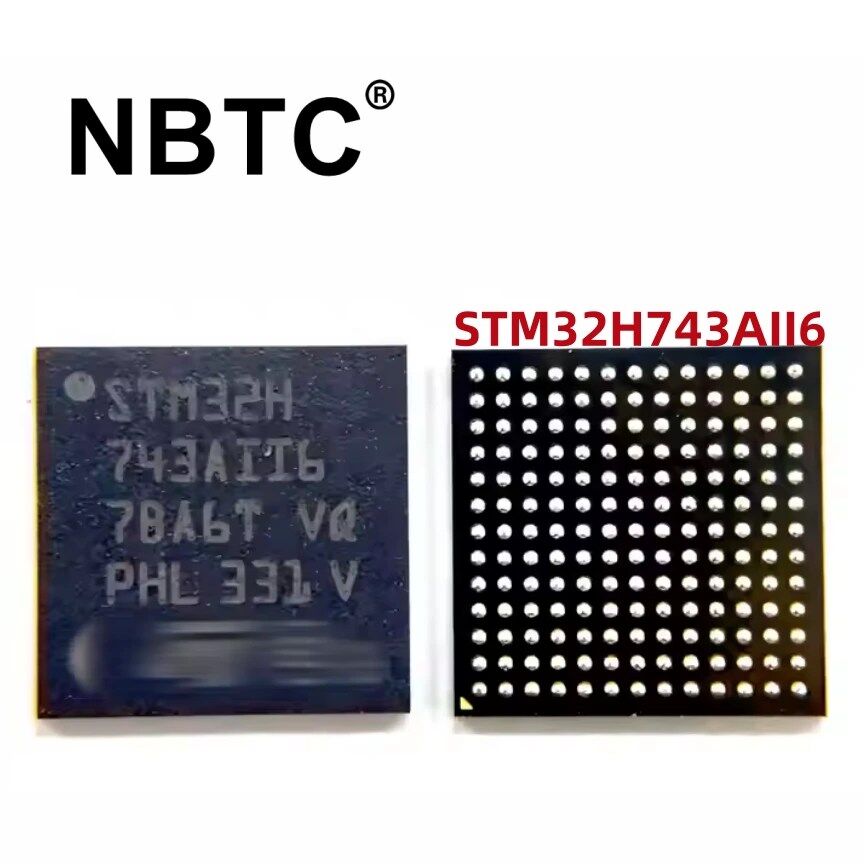描述
High-Speed STM32 MCU STM32H743AII6 Microcontroller IC 2MB Flash 1MB RAM 1.62V-3.6V 480MHz UFBGA-169 for Motor Control Original
1.62V~3.6V 480MHz 1MB FLASH 2MB Brown-out Detect/Reset/DMA/I2S/LCD/POR/PWM/WDT Internal 131 1 1.62V 3.6V 480MHz CANbus/EBI/EMI/Ethernet/I2C/IrDA/LINbus/MDIO/MMC/QSPI, SAI, SD/SDIO/SPDIF/SPI/SWPMI/UART/USART/USB OTG 32bit ARMCort-M7 UFBGA-169 SMD installation 7mm*7mm*530μm
Product Description
STM32H743AII6 is a high-performance 32-bit microcontroller (MCU) launched by STMicroelectronics (ST), based on the ARMCorT-M7 core, designed for complex embedded application scenarios that require high computing power, rich peripheral interfaces and low power consumption.
Features
1. Core architecture:
Processor: 32-bit ARMCort-M7, supporting double-precision floating-point unit (FPU) and DSP instruction set.
Main frequency: up to 480MHz, providing 1027 DMIPS computing power (Dhrystone 2.1 benchmark test).
Cache: integrated 16KB data cache and 16KB instruction cache (L1) to accelerate data processing.
2. Storage configuration:
Flash: 2MB, supports parallel execution of read and write operations.
RAM: 1MB in total, including:
TCM RAM: 192KB (64KB instruction TCM + 128KB data TCM, for time-critical tasks).
User SRAM: 864KB.
Backup SRAM: 4KB (supports data retention in low power mode).
3. Power and power management
Power supply range: 1.62V to 3.6V, adaptable to wide voltage environment.
Power domain: 3 independent power domains (D1 high-performance core, D2 peripherals, D3 power control), support flexible clock gating and shutdown.
Low power mode: sleep, stop, standby mode, standby power consumption as low as 2.95μA (backup SRAM off, RTC/LSE on).
Power monitoring: integrated POR (power-on reset), PDR (power-down reset), PVD (voltage detection) and BOR (undervoltage reset) functions.
4. Clock and reset management
Internal oscillator:
HSI: 64MHz
HSI48: 48MHz
CSI: 4MHz
LSI: 32kHz
External oscillator:
HSE: 4-48MHz
LSE: 32.768kHz
Phase-locked loop (PLL): 3 (1 system clock PLL, 2 core clock PLL, support fractional mode).
5. Peripheral interface
1. Communication interface:
I2C: 4 groups (support SMBus/PMBus).
USART/UART: 4 groups (including 1 LPUART low-power serial port).
SPI: 6 groups (3 groups support I2S audio, 1 group supports 150MHz high-speed mode).
USB: 2 groups of OTG interfaces (1 group FS, 1 group HS/FS, support crystal-free solution).
CAN: 2 groups (support CAN FD and time-triggered CAN).
Ethernet: MAC interface (with DMA controller).
Others: HDMI-CEC, SWPMI single-wire protocol, SDIO/MMC (up to 125MHz), SPDIFRX, etc.
2. Analog functions:
ADC: 3 groups (16 bits, 36 channels, sampling rate 3.6MSPS).
DAC: 2 groups (12 bits, output rate 1MHz).
Operational amplifier: 2 groups (bandwidth 7.3MHz).
Comparator: 2 groups of ultra-low power comparators.
Digital filter: Support Sigma-Delta modulator (8 channels/4 filters).
6. Graphics and multimedia
6.1. LCD controller: Supports XGA resolution (1024×768).
6.2. Hardware accelerator: Chrom-ART graphics accelerator (DMA2D) to reduce CPU load.
6.3. JPEG codec: Hardware implementation of efficient image processing.
7. Timer and watchdog
7.1. High-resolution timer: 1 group (2.1ns accuracy).
7.2. General timer: 10 groups of 16-bit timers (up to 240MHz).
7.3. Motor control timer: 2 groups of 16 bits (support PWM/encoder input).
7.4. Low power timer: 5 groups of 16 bits.
7.5. Watchdog: 1 group each of independent watchdog and window watchdog.
8. Security and debugging
8.1. Anti-tampering: Support ROP (return-oriented programming) and PC-ROP detection.
8.2. Unique identification: 96-bit unique device ID.
8.3. Random number generation: True random number generator (based on 3 oscillators).
8.4. Debug interface: SWD and JTAG, support 4KB embedded trace buffer.
9. Packaging and compliance
9.1. Packaging: UFBGA-169 (7×7mm), compliant with ECOPACK2 environmental standards.
9.2. Operating temperature: -40℃ to +85℃, suitable for industrial-grade environments.
Applications
1. Industrial automation: PLC control, motor drive, inverter, circuit breaker.
2. Automotive electronics: vehicle network, sensor fusion, safety control.
3. Internet of Things: gateway devices (Ethernet/USB connection), remote monitoring.
4. Consumer electronics: audio devices, wearable devices (such as smart watches).
5. Medical equipment: multi-sensor data acquisition and real-time control.
